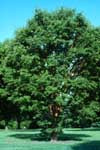Acer griseum
 |
 |
 |
|
Paperbark Maple |
Leaves of Paperbark Maple |
Bark of Paperbark Maple |
Summary
Foliage: Deciduous broadleaf
Height: 20 to 30 feet
Spread: 10 to 30 feet
Shape: Spreading
Summer foliage is dark green, changing to brown- to-red in fall. Ornamental bark is a copper color.
Plant Needs
Zone: 4 to 8
Light: Partial shade to full sun
Moisture: Wet, moist, to dry
Soil Type: Sandy, loam, or clay
pH Range: 3.7 to 7.0
Functions
Suggested uses for this plant include specimen plant.
Planting Notes
Plant in spring. Select plants that have balled and burlapped roots or that have been container grown. Tolerates a wide range of soils and exposures.
Care
May need extra water during hot, dry summers. Water deeply by saturating the soil once a week. Place hose at base of plant and allow water to trickle into soil.
See Soil Improvement
Problems
No serious problems.
Alternatives
Consult local sources, including historic or public gardens and arboreta, regarding cultivars and related species that grow well in your area.
Cultivars of ACER GRISEUM
No important cultivars.
Comments
Paperbark Maple is a round-headed, rather open maple that grows moderately fast when young. Paperbark Maple is best used as a lawn or specimen tree where it is visible in the winter.
This material was developed by Carol Ness as part of the Interactive Design and Development Project funded by the Kellogg Foundation. Mary Miller, Project Director. Diane Relf, Content Specialist, Horticulture. Copyright 1989 by VCE.

